

There was a time where it was nearly impossible to compile a list of famous folk who had come forward with being prone to the Khronic Kondition Kalled psoriasis. Now, due to the pressures of reality TV and the Kompetitiveness of one Kim Kardashian, examples are breaking out, well, like a rash. In the summer of 2011, while taping an episode of "Keeping Up with the Kardashians.," Kim Klaims to be blind-sided by her diagnosis of psoriasis. Mystified by an itchy eruption on her trunk and legs, she is told by her sister it might be "ringworm."
Kim's reality (show) is rocked by skin spots. What could they be?
Kim's reality (show) is rocked by skin spots. What could they be?

Kim is itching for an answer. Her derm makes the call. Psoriasis, all right.

Rather than a fungal infection, her dermatologist provides the accurate diagnosis, psoriasis, a Kommon inflammatory condition. Though not Kontagious, psoriasis is triggered by genetic signals, and currently there is no Kure. Okay, you get it, we'll drop the "K" gag. Fine. Kardashian gets a bit panicky, since her fortune and fame stem from beauty, exhibitionism and product endorsement. Can a skin-challenged Kim still sell Skechers?
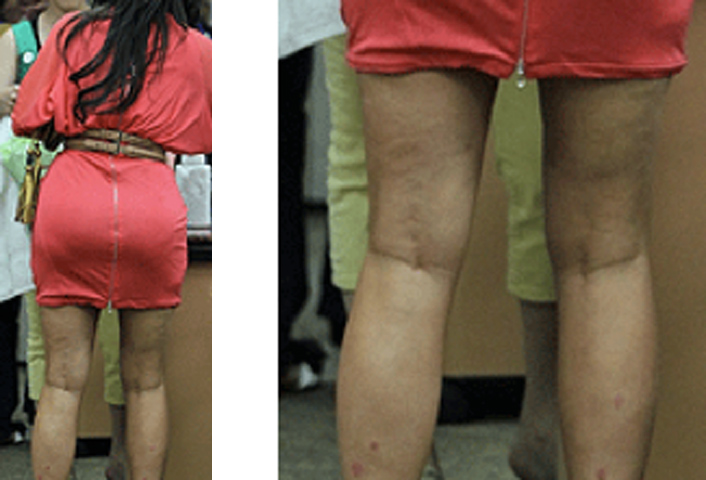
Fortunately for Kardashian (and the global economy), her version of this condition is the guttate or "raindrop" pattern of psoriasis. This mildest and most treatable form sometimes results from bacterial infections, such as strep throat. The body's immune reaction to the germ causes the inflammatory lesions to appear on the skin. Guttate psoriasis usually responds to topical prescription cortisones, vitamin D creams and UV phototherapy. Compared to other forms of psoriasis, it is more likely to clear with these treatments and go into remission. So it's unlikely that Kim will end up shilling for psoriasis salves. Or that the show will be renamed "Keeping Up with the Kar-Rashians."
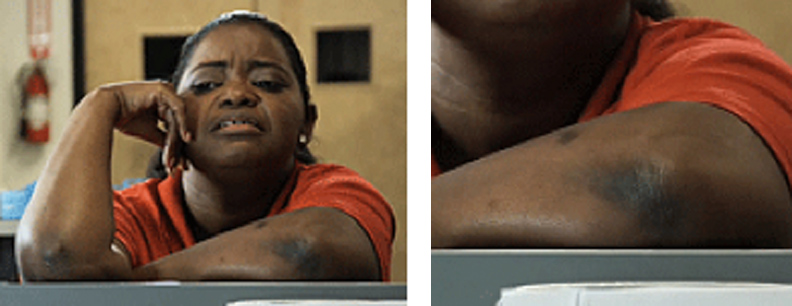
Runners-up, Celeb Psoriasis Sufferer: Octavia Spencer, "The Help"
The Golden Globe winner shows dark, scaly elbow plaques... ...the classic appearance of treated psoriasis.
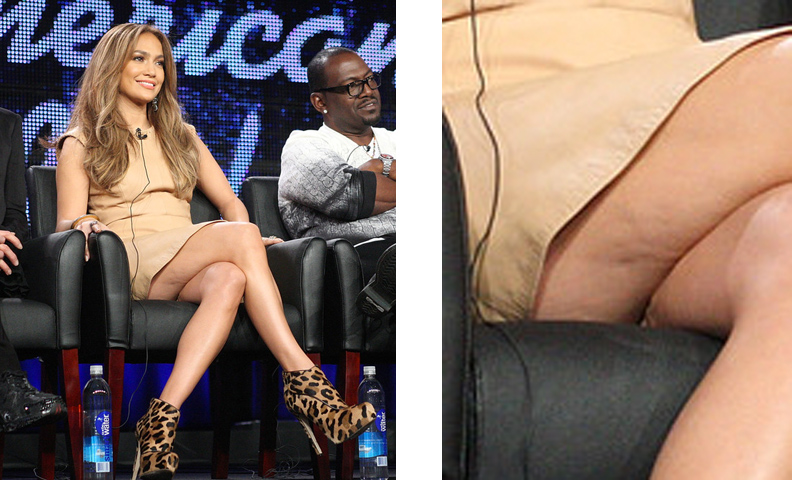
With her stint as an “American Idol” judge, and the release of a new album, Singer/Dancer/Phenomenon Jennifer Lopez' career underwent an impressive resurgence. To top it off, she ranked first in People magazine’s list of Beautiful People of 2011. Yet there is something J-Lo understandably wants to keep on the Down-Lo. Her celebrated curvy figure also has some mini-curves that most find less desirable: the epidemic affliction known as cellulite.

Presumably concealed or photoshopped out of most of Lopez' publicity pics, her significantly dimpled thighs are occasionally revealed. The cause of cellulite remains a tremendous area of research, rivaling the quest to figure out how Justin Bieber maintains such an extreme level of cuteness. The latest thoughts are that fat cells collect around dense tissue bands that are pulled down to leg muscles. Clearly, very little has been learned since our review of this sinister subject in 2008!
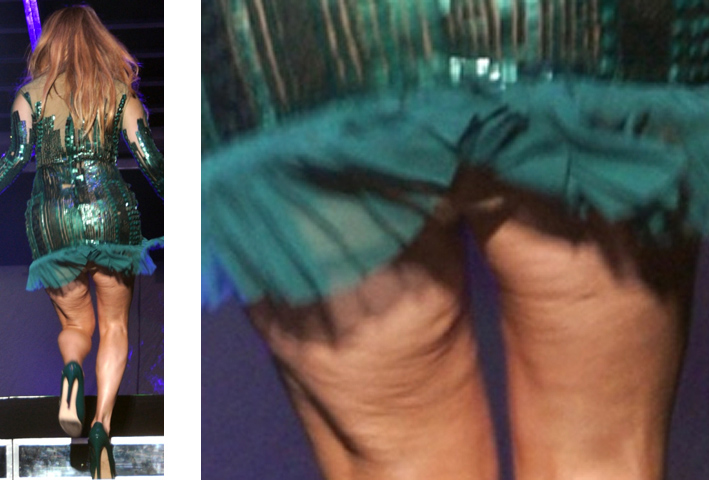
Unfortunately, this doesn't stop the promotion of firming creams and devices claiming to treat this aesthetic plague. Putting the "sell" in cellulite, endermologie, mesotherapy, lasers, countless goops and potions all purport to reduce the rumpled appearance, supposedly promoting smoothness, beauty and world peace.

Yet if any of these treatments were effective, even at a cost that only the top one percent of the “One Percent” could consider, wouldn’t someone like Lopez leap (and shimmy) at the chance? Unless one wants to selflessly invest in the economy, creating jobs for those toiling on these “treatments” that show no impressive track record, it’s probably better to eat right, enjoy exercise and use sunscreen to maintain the glamour. The year that there is an effective treatment for cellulite, we presume Jenny on the Block will be the first in line.

Runner-up, State Secret: Whatever is Under Santana’s Hats
Long before J-Lo began hiding her thighs, fellow Latin artist Carlos Santana starting wearing hats constantly in public. The last image showing the top of the Rock Icon’s head was likely when Disco balls were considered cool, not cliché (that would be in the 1970’s, young folk). Why the cover up?
We assume, like fellow Dinosaur era rockers Peter Frampton and Peter Gabriel, Santana probably has a vanishing hairline. Hair loss can be treated (pills, creams or hair transplants) or embraced. At least hats provide sun protection. Time and hair lines march on. Peter Frampton in the 1970's... ...and 2000's. Prog rocker Peter Gabriel early... and later. We assume, like fellow Dinosaur era rockers Peter Frampton and Peter Gabriel, Santana probably has a vanishing hairline. Hair loss can be treated (pills, creams or hair transplants) or embraced. At least hats provide sun protection.


In 2011, we learned that politics and public health don’t always campaign on the same ticket. During one of the countless Republican presidential nominee debates, Governor Rick Perry took some spicy Texas level heat. In 2007, he had tried to require students to undergo a vaccination that has been shown to prevent cervical cancer. While this seems a no brainer (Cancer: bad! Health: good!), the way the vaccine works gives some folks pause.

Up to 80% of cervical cancers are due to the forms of Human Papilloma Virus (HPV) that can also cause genital warts, an STD. Dermatologists treat warts in all forms, genital or otherwise, often with freezing treatments (cryotherapy, left) and immune boosting topical creams. Usually, a lifelong immunity to wart strains eventually occurs, but can take many visits and procedures. A form of preventative medicine, the HPV vaccine can safely insure protection against the four wart virus strains that cause genital lesions, cervical cancer and some forms of throat and anal cancer. The vaccine is administered with three sessions over a 6 month period.
In an effort to insure best prevention, in 2006 the US FDA approved the vaccination for girls (and now boys) as young as 9 years old. Presumably some parents are concerned that early vaccination might cause teens to participate in risky sexual behavior. In late 2011, a study showed the opposite, that vaccinated girls were less likely to undergo unprotected sex, instead “always” using a condom.
In an effort to insure best prevention, in 2006 the US FDA approved the vaccination for girls (and now boys) as young as 9 years old. Presumably some parents are concerned that early vaccination might cause teens to participate in risky sexual behavior. In late 2011, a study showed the opposite, that vaccinated girls were less likely to undergo unprotected sex, instead “always” using a condom.

The concept of vaccinating children for a future STD can be jarring, prompting a hilarious Saturday Night Live parody, The “Lil Poundcake” doll. While girls play with the doll, it occasionally produces a hypodermic needle, vaccinating girls by surprise.

Girls play with the doll...
...and get a sporadic injection.
Thanks, Lil Poundcake!

Candidate Michele Bachmann further muddied the waters by claiming that a parent had told her that her vaccinated “daughter suffered mental retardation as a result.” In the clinical trials, 1 % of recipients had side effects, and 8% of those were serious, but none involved mental problems. Given the excellent safety record of the vaccine, for Bachmann to go public with this comment without checking the facts seems, well, retarded.

Hopefully, now that the field of nominees is thinning, political skirmishes can be separated from health policy. Safely preventing warts and cervical cancer? That seems something for which we can all vote.

Runner-up, Political Football: Medicare
For yet another year, Congress can’t figure a way to consistently fund the program on which millions of American seniors rely. If it is substantially cut in 2012, it is unclear how much Botox would be needed to reduce the epidemic frowns and grimaces.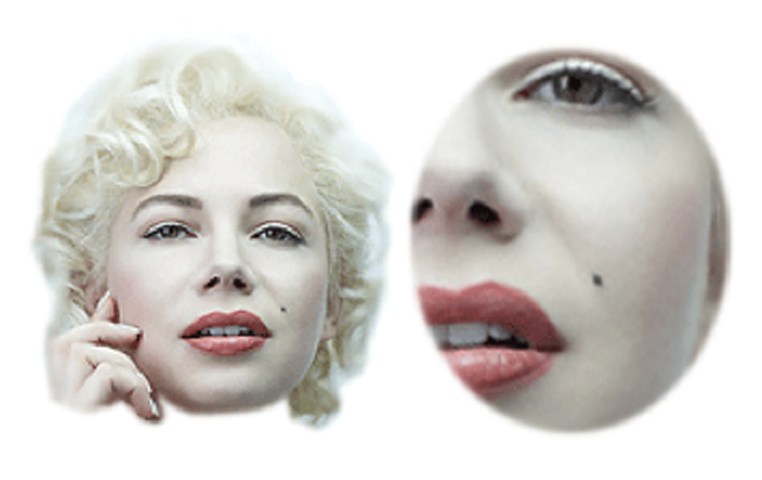

How to describe her? Let’s count the ways. Small. Dark. Flat. Either left or right leaning, never in the center. Discrete. Distinctive. Enduring. Long a Hollywood staple, the Beauty Mark had a huge comeback in 2011, proving her to be the “Go-to” lesion once again.

She was front and foremost in the silent film tribute, “The Artist.” Jean Dujardin is looking for something to boost the fame of fledgling ingénue Bérénice Bejo. Stating that she needed something unique to make her stand out from the other starlet wanna-be’s, he uses an eyebrow pencil to place a beauty mark on her upper lip.

Bejo’s film career takes off. The mark is so important to providing her recognition that her first feature film is actually called “Beauty Spot.”

In “Tinker Tailor Soldier Spy,” a low level operative becomes enchanted with a Russian spy. Is his smitten with her Balalaika skills, or her small exclamation point of a mole?

And of course, no biopic of film phenom Marilyn Monroe would be complete with her signature facial accent: the mark that lit up a thousand marquees. Many have raved over Michelle Williams’ turn as the troubled icon in “My Week with Marilyn.” Yet without the help of makeup artistry recreating Monroe’s signature spot, Williams wouldn’t have had a chance.

The Beauty Mark had an established career before the invention of celluloid, used to heighten the features of the aristocracy. Some have postulated that marks were used to conceal small pox scars. The mole’s enduring popularity has survived into an era where smallpox, and even chickenpox, are being eradicated with the use of vaccines.

Actresses Blake Lively and Eva Mendes are among the countless celebs whose small asymmetric facial moles accentuate their success. Blake Lively "Blake-ette" Eva Mendes "Mendita"
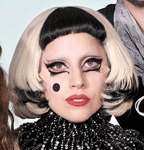
What is the secret of this career longevity? In childhood and adolescence, most moles initially develop as distinct, flat and dark lesions. Later, with age, those same spots can become more raised, flesh toned and droopy, looking more warty than winsome. As an American Idol coach, Lady Gaga created a lesion that looked Ga-ga-garish, like a birthmark gone bad.

Also, much like real estate, it’s all about location, location, location. Beauty marks are strategically situated near the mouth or eyes, features that are proportionately larger in young adults. For example, a dark spot on the tip of the nose is not usually associated with glamour. The Beauty of the Mark is therefore its association with youth and fertility, aspects that like the spot itself, never seem to go out of style.

Runner-up, Lifetime Achievement Award: The Facial Scar
In this year’s tightest Skinnies matchup, the Hollywood facial scar scored a just a cut below the beauty mark. Since scars can ID both bad guys as well as heroes (a certain Muggle loving wizard for example), we expect big things for The Scar next year.

In "The Help," Bryce Dallas Howard plays Hilly Holbrook, this summer's most vindictive villain since Lord Voldemort. As a young socialite in 1960's Jackson, Mississippi threatened by the changes coming with the African American civil rights movement, Hilly is not above capriciously firing, slandering and falsely accusing maids that get in her way. She is punished, not just in the form of a culinary surprise, but also skinematically: she has herpes.

To clarify, actress Howard (daughter of Opie Cunningham, otherwise known as actor/director Ron Howard) does not have a chronic viral infection. This prominent cold sore is created via makeup to illustrate her character's moral defects. Often triggered by sun exposure and emotional or physical stress, outbreaks can be painful and decidedly un-glamorous. We take issue with the concept that herpes is a marker for evil. This common infection strikes all comers, no matter the direction of their moral compass.

Fortunately, a lot has changed since the early 1960's, not just in the area of civil rights. With the advent of antiviral pills, such as Valtrex (valacyclovir), outbreaks can be quickly treated or suppressed entirely. And like human rights, we still have a way to go. Once developed, a vaccination or cure for herpes infections will be as welcome as tasty Southern fried chicken.
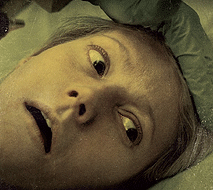
Runner-up, Villainous Virus: Epidemic Flu in "Contagion"
Sure, it killed Gwyneth Paltrow, but no skin rash? Puh-leese!

How times have changed. For decades, tattoos seen in movies indicated bad guys and bums. This has been the case, even in the last 10 years when tattooing by the general public reached a level of popularity only rivaled by the number of views of Rachel Black’s attempts at singing on YouTube. At long last, movie characters with body art are featured as champs, not chumps. And the current queen of heroic tattooed triumph: Lisbeth Salander, the eponymous Girl with the Dragon Tattoo.

Whether played by Swedish actress Noomi Rapace or American thesp Rooney Mara it is clear that Salander can only be portrayed if you have a quirky first name that features two "o's". As the modern answer to James Bond, Salander kicks serious butt. She solves mysteries, hacks into any tech device and rides a mean motorcycle. All this without scraping her tatts or having her piercings snag on Swedish foliage.

The film shows epic product placement for skin ink. Not only does the camera lovingly fixate on Lisbeth’s designs, she is actually shown adding more to her collection. In a selfless act of giving, she tattoos the belly of her rapist as a helpful warning to potential future victims. To top it off, the featured product, "Tattoo," is in the movie’s title. Take that, Transformer franchise!
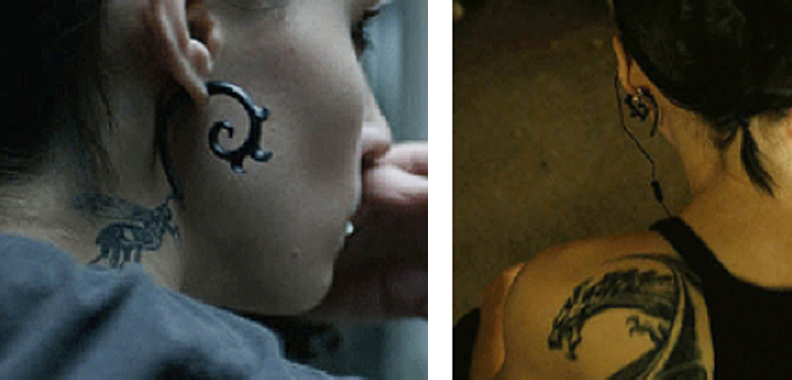
Salander will no doubt always love her tatts. But some outside of the action movie star profession tire of their “illustrat-skins” and desire removal. Lasers can gradually fade most tattoo pigments, usually without scarring. The key word is “gradually.” Blue black pigment, which best absorbs laser energy and so shows the fastest rate of removal, may still require 3 sessions minimum for clearance over several months. Other colors can take even longer.
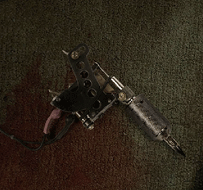
Researchers as clever as Lisbeth have developed a new version of tattoo ink called InfinitInk. While it looks like a normal tattoo, the pigment is primed for a more efficient response to laser treatments. The makers claim that it clears 3 times faster that normal skin ink. Like we said, times change, and sometimes that twenty-something tatt needs to be left in the past.

Runners-up: Champion with the Most Body Art
Dwayne Johnson from “Fast Five.” Ed Helms from “The Hangover Part II”
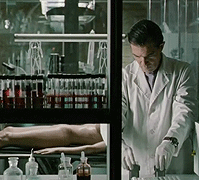
In this era of increasing realistic CGI effects, we have to be reminded that movies and reality exist in separate universes. Case in point: Plastic surgery results. Plastic surgeons are trained alter the shape of the face, lifting droops, filling valleys, tightening laxity. To achieve these results, some cutting of the skin is involved. Scars are the natural result, but making scars small and hidden is a large part of the surgeon’s training and skill.
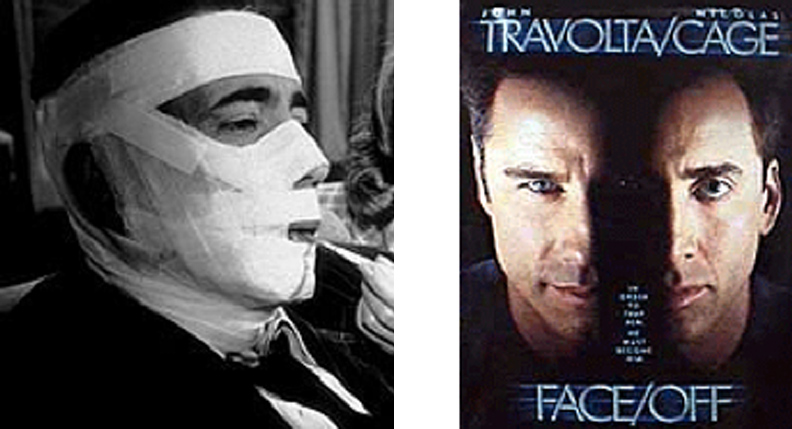
In movies, however, dramatic surgical interventions are performed that magically involve no scarring at all. In “Dark Passage,” (1947), an escaped convict undergoes plastic surgery and ends up looking exactly like the actor Humphrey Bogart. In “Face/Off” (1997), Nicolas Cage and John Travolta have their faces transplanted from one to the other. Downtime, healing issues, scarring? Not seen onscreen.
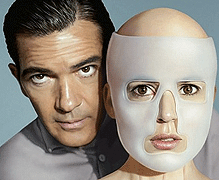
In 2011, quirky Spanish director Almodovar released “The Skin I Live In” starring “Puss In Boots” himself, Antonio Banderas, as a brilliant but twisted plastic surgeon. After his wife and daughter commit suicide, he proceeds to kidnap an individual and gradually transform that person into a replica of his dead wife. Through a series of procedures, he manages to recreate her appearance.

The result, played by actress Elena Anaya, is not just scar-free, but by most conventional standards, super hot. Disclaimer: Just because this subject matter warrants discussion at skinema.com, the editorial board, investors and custodial staff in no way recommend the film. Though trying for Hitchcock, the result is “Saw” meets an Adam Sandler gender bender. And not even as fun as that might sound. We warned you!

In “Sherlock Holmes, A Game of Shadows” two “twins” are actually a man and then someone else who has had plastic surgery to mimic his appearance. This in the 1890’s, long before sterile technique and the availability of antibiotics. Amazingly, there is no infections, scarring or deformities. Disclaimer: Just because we are discussing this latest in the Robert Downey Jr. franchise does not mean that the writers, researchers and window washers at skinema.com are lending the flick our endorsement. The plot was so convoluted that we are not sure what the significance of these “twins” were to the story. You heard it here first. Or maybe second.
In reality, extensive plastic surgery cannot be achieved without significant scarring. Recently, new breakthroughs have occurred. Not just modifying an existing face, but transplanting a face from one person to another. A handful of face transplants have been performed in the recent past on individuals whose faces had undergone deforming trauma. These people have to remain on medicines that suppress the immune system’s tendency to reject the foreign tissue. While it is better to be face-full rather than face- less, both for cosmetic and functional reasons, the results in our universe (as opposed to the movie-verse) look like this:
In reality, extensive plastic surgery cannot be achieved without significant scarring. Recently, new breakthroughs have occurred. Not just modifying an existing face, but transplanting a face from one person to another. A handful of face transplants have been performed in the recent past on individuals whose faces had undergone deforming trauma. These people have to remain on medicines that suppress the immune system’s tendency to reject the foreign tissue. While it is better to be face-full rather than face- less, both for cosmetic and functional reasons, the results in our universe (as opposed to the movie-verse) look like this:
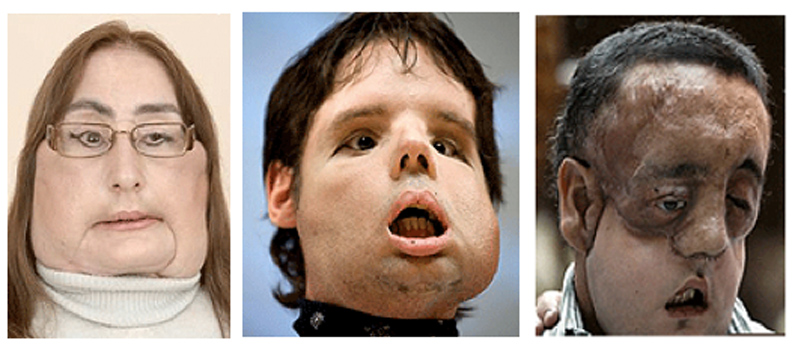
"Successful" face transplant results...
...performed in the real world...
...without movie special effects.

Outside of movies, there seems very little risk that people will elective undergo face transplants just to mimic their fave celebs. Vicariously seeing the process in films should be enough. Kids don't try this at home.

Runner-up, Hollywood Fantasy Treatment: Those masks in the "Mission Impossible" movies
Cool concept and one that could make dermatologists obsolete. Bad complexion today? Just crank out a new instant face mask. Caveat: They don't exist, with or without a multi-million dollar blockbuster budget.In the MI flicks, there is always some dude... ...who looks nothing like Tom Cruise... ...who actually turns out to be Tom Cruise.
« Back




